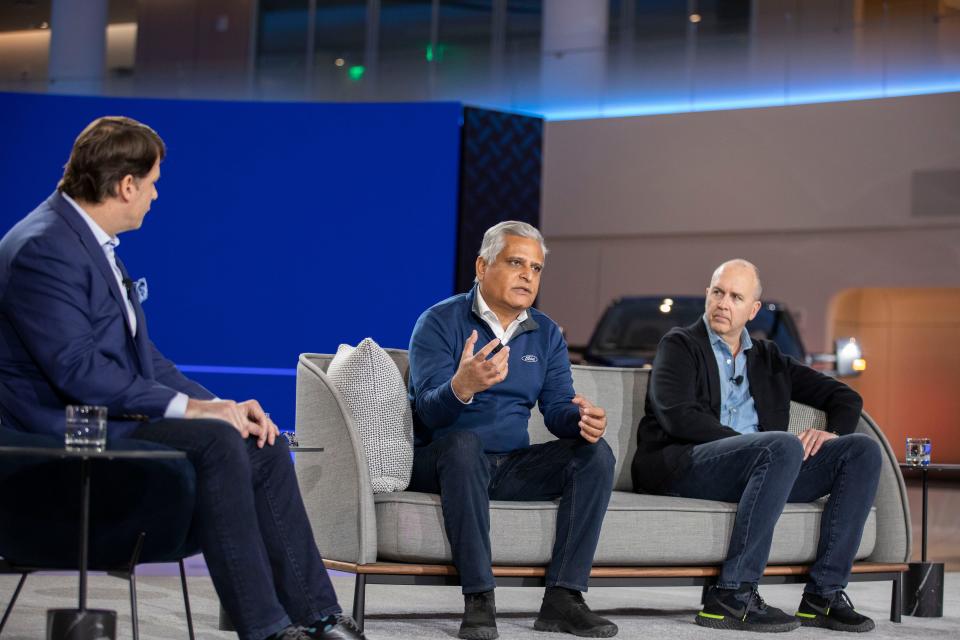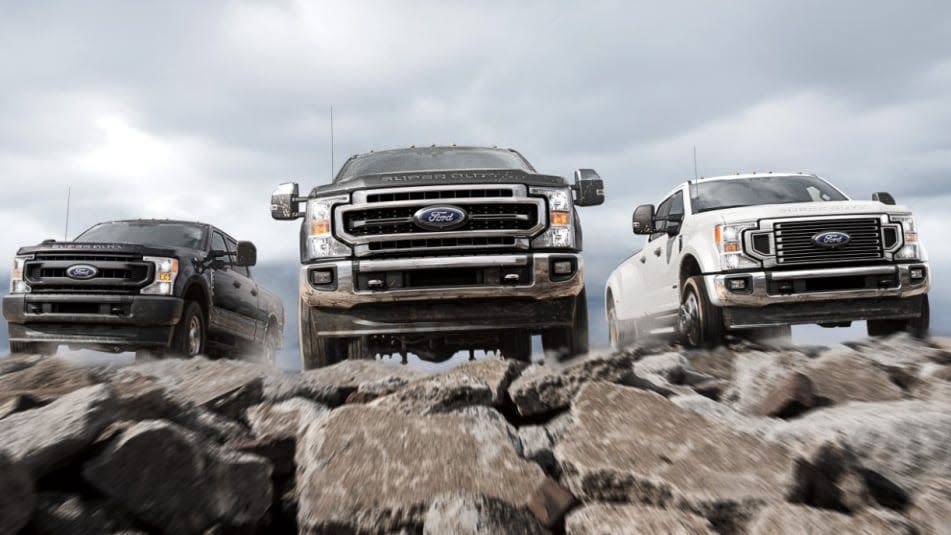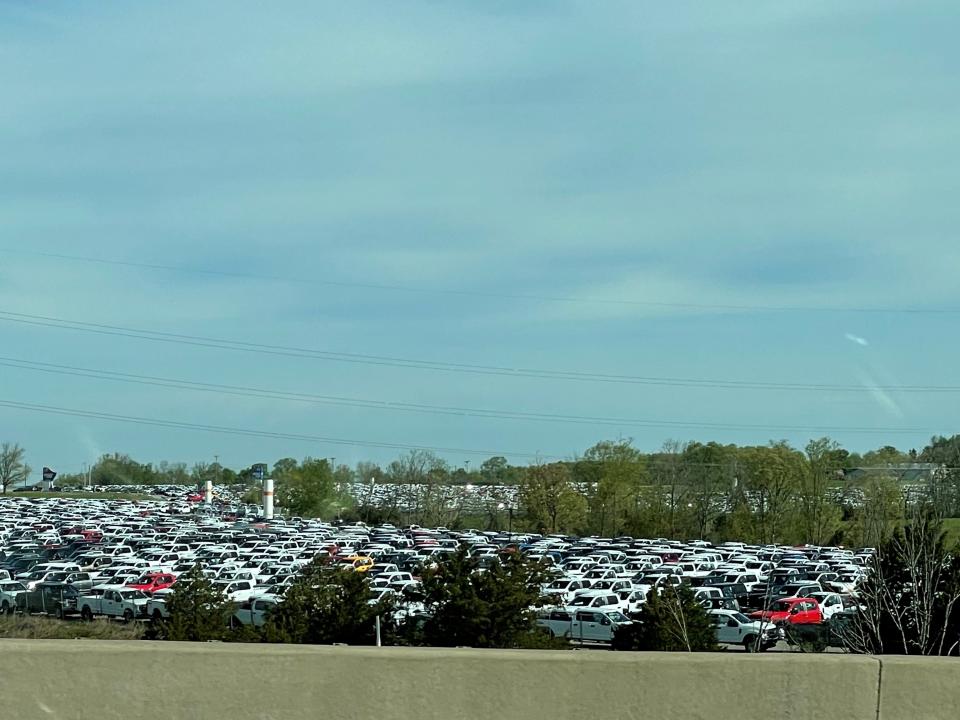Finding balance at Ford Motor Co. right now is, well, delicate.
Wall Street has applauded recent restructuring changes while some workers cringe.
The “disruption at the human level” will be “very difficult” as the legacy automaker continues making dramatic staff changes designed to help the company compete in an increasingly dynamic environment, Ford CEO Jim Farley said this month.
Pivoting from internal combustion engines (ICE) to electric, and dividing the company into gasoline- and electric-focused teams, carries uncertainty and fear.
“My grandfather worked at the Rouge plant and those jobs are going to change,” Farley told an audience March 10. “Over time, when we get to 40% electrification, we’re not just going to add 40% more volume. It’s going to be substitutional. …
“Those ICE jobs or engine transmission or assembly jobs, the suppliers, the dealers — It will change a lot. … If we do it right, we’ll grow so there will be more work for everyone. But it will be different jobs — a battery plant job. A job making electric motors is totally different than what we do today.”
On Monday, Ford announced hiring Jennifer Waldo from Apple to take the top human resources role as someone who has led organizational change and recruited talent specifically for competitive high-tech jobs.
Christopher Smith, a former Department of Energy official with expertise in government regulation and sustainability, begins his role as Ford chief government affairs officer in Washington, D.C., next month managing domestic and global strategy.

A room filled with people during the talk earlier this month listened to Farley go on about the importance of the F-Series pickup truck franchise to generate the billions needed to pay for electric vehicle investments.
“The hardest thing I think we’re facing now, is, how do you tell a team that’s funding all of this — knowing that the volume is going to go down, knowing that there will be less work — how do you get them motivated to do that work while we’re building these digital zero emission vehicles?” Farley asked.
Tattoo you
Part of the problem, he said, is that people fail to appreciate the ongoing value of Ford vehicles some consumers love so much that images of the vehicles — the F-150 and classic Mustang — are tattooed on various body parts.
But even though climate change is a global issue, and reducing emissions that contribute to the problem is a top priority among governments all over the world, the bigger opportunity is to make cars digital products.
“I think people actually get the transformation of the car companies wrong,” Farley said. “Fundamental change for us is two things: Being able to have a digital product where you make the product better every day through over-the-air updates,” much the way mobile phones and computers update now.
“The real problem with our vehicles are, they’re not smart,” Farley said. “To control a car, we need 3,000 semiconductors. We have about 140 modules that control the vehicle — window control module, transmission control module. Every one of those are outsourced to tier one automotive suppliers. The software isn’t owned by us. If we want to update the software on any of those … we have to go get permission from our own suppliers.”
‘Totally different talent’
Creating advanced electrical architecture like what’s used on the cellphone, Ford can change the vehicle to include “predictive failure” for its vast number of commercial customers to avoid unplanned downtime, for example.
“And that requires totally different talent,” Farley said. “We don’t have that talent at Ford. But we have to make sure that talent works with the people at Ford. That’s one thing.”
Next is a need for shared mobility and the opportunity to rent rides, because fewer and fewer people can afford vehicles.
“Electrification is going to make it worse, actually,” Farley said.
The biggest fleet in the U.S. is Uber drivers with 1.2 million on the road, and the ride-sharing service doesn’t use vehicles designed for them, he said. “All the vehicles are converted retail vehicles. They’re not optimized for a ride-sharing person who’s running a business.”
All of this points to development of new products with new talent.
More: Ford ramps up as the fight for EV domination in Europe heats up
More: Ford’s plan to direct $3B from gas vehicles to fund electric, tech
No one at Ford is using the term layoff or buyout but Kumar Galhotra, president of Ford Blue, has said the automaker will be working with employees to make the transition.
“Everything is on the table. It has to be. If we’re going to take out $3 billion over the next two to three years … we’re going to work with all our partners to do this in a very integrated way,” he told reporters earlier this month.

Directing Ford Blue to focus on the bestselling pickup trucks, SUVs and vans with a different Ford Blue team working on tech development is a resolution to inefficiency, Farley said.
“I kind of was watching the management team struggle with this transformation from 7 to 8 they were working on chip supply, from 9 to 10 they were trying to find lithium and nickel, from 10 to 11 they were working back on emission control for a Super Duty,” he said. “You just can’t ask people to do that many different things.”
More: Ford CEO hired Doug Field away from Apple in ‘huge coup’
Manufacturing and technology will continue to collaborate, but Farley wants experts in certain fields to move the company forward more quickly and efficiently.
A Super Duty customer won’t buy an all-electric vehicle anytime soon because the physics aren’t far enough along to haul huge loads for long distances in extreme temperatures on steep terrain, he said.
Up to 50% of business is expected still to come from gas-powered vehicles by the end of the decade, and those vehicles provide a crucial funding stream, Farley emphasized.

But gasoline vehicles still need over-the-air technology updates to keep technology current.
“There will be a lot of tensions in this new (company) design,” Farley said. “We’ll see how it goes. We’ll see if our bet is right or not.”
This next stage, when Ford must produce high-volume, battery electric vehicles, is when supply chain control is key to the overall strategy, he said.
“All the way back to the mines,” Farley said, noting joint ventures with battery companies and an effort to in-source power electronics and silicon, the inverter, the motors.
“We have to do all that. It’s a completely different work statement,” he said. “We’re in a moment where supply chain is a strategic advantage. Not just the best product wins.”
Wait, what?
Farley told of an epiphany during a conversation with Chuck Robbins, CEO of Cisco Systems, a technology company that develops, manufactures and sells software, telecommunications equipment and wireless security systems and services.
When describing the supply chain for electronic components — including semiconductor chips, memory chips, custom silicon, which are now 20% to 30% of the content of a vehicle from a cost perspective — Farley described a dated inventory system that lines up raw-material orders from suppliers to coincide with production schedules.
Robbins was stunned.
“‘He’s like, ‘You run that on ‘just in time?’ I said, ‘Yep.’ He was, like, ‘If you single source one of those, do you have a design on the shelf, an alternative, already engineered?’ No. ‘Do you have software to get around limited chips?’ No. He’s like, ‘I can’t believe you run your whole industry system that way,’ ” Farley said March 10.
That moment seemed to reinforce what the new Ford CEO knew intuitively.
More: Ford CEO gives employees sobering data about Tesla, challenges ahead
More: Ford CEO says automaker is sold out of electric vehicles: What it really means
“We have to run our supply chain differently than we have,” Farley said. “Just-in-time works great for instrument panels and seats but it doesn’t work great for these key electronic components that are going to be really critical.”
New roles
This means Ford will need to go around its suppliers and “go right to the supply chain ourselves, do physical inspections, have alternatives engineered in case there are constraints, lots of joint planning on capacity, looking at the technology road map,” Farley said. “So that’s one thing we have to do.”
In addition, having access to raw materials for essential batteries needed to make all-electric vehicles is crucial. Part of that is battery recycling and reuse done through the partnership with Redwood Materials announced in September.
And part of it will be battery chemistry, Farley said.
People at Ford aren’t doing these jobs today.
On the hunt for talent
Sam Fiorani, vice president of global vehicle forecasting at AutoForecast Solutions, said the auto industry so rarely learns from its mistakes that news of the Farley thinking on raw materials is refreshing.
“Companies decide just-in-time (delivery) is the answer to everything and they don’t have any warehousing,” Fiorani told the Free Press on Monday. “The Idea is that outside suppliers can specialize in seats or fuel injection systems or whatever you need. So you rely on that one supplier to supply all the seats and fuel injector systems.”
This creates too much constraint, he said. “If you don’t have some parts on hand, some warehousing, and if there’s a problem, you’re going to be stopping production in a day or two or three.”

Farley’s description of employees who will be needed sounds like people who haven’t spent their whole lives making internal combustion engine vehicles, Fiorani said.
“They need to know about batteries, motors, electronics to improve the supply chain,” he said. “People at Ford should be comforted they’re not thinking six months down the line. They’re thinking six years down the line.”
People at Ford Blue should have secure jobs probably for the rest of their careers, because ICE vehicles aren’t going away tomorrow, next year or in 10 years, Fiorani said. “But they have to be prepared for the next era of vehicles, which are going to be digital.”
This means more electrical engineers and fewer mechanical engineers, he said.
A car or truck is a traditional analog. It has a gasoline engine that turns the transmission that turns the wheels. That hasn’t changed in 100 years.
Meanwhile, Marick Masters, a professor at the Mike Ilitch School of Business at Wayne State University, said time is too precious to not make more strategic acquisitions to fulfill immediate needs at Ford.
“It’s probably too time-consuming for Farley to groom and develop that talent in-house. The scope of tasks that he has to complete in order to deal with issues associated with supply chain in a highly turbulent environment are too complex to take on on your own,” Masters told the Free Press. “I think what he needs to do is acquire companies that have the capacity to do this, to a large extent, stand-alone operations that can feed into an existing corporate structure.”
Farley has said during recent presentations to industry analysts that more announcements are coming.

Yet Ford faces continued pressure to eliminate costs and focus on electrification, and that means anything and anyone who lacks the necessary new skills to meet that objective is “expendable,” Masters said.
All these decisions are being reevaluated during a time of global and political conflict as well as transportation supply disruption.
The opportunity to remake an American icon is “evocative,” Farley said March 10.
“So I would say, ‘make the change every day. Take a step. Make sure that your step is going to make a difference.’ But I think the most exciting thing is we have a chance to reinvent the company that put the world on wheels. We have not had that chance for over 100 years. So what the hell (are) we waiting for?”
Contact Phoebe Wall Howard: 313-618-1034 or [email protected]. Follow her on Twitter @phoebesaid. Read more on Ford and sign up for our autos newsletter.
This article originally appeared on USA TODAY: Ford CEO says automaker needs ‘totally different talent’ to meet goals
Source: https://finance.yahoo.com/news/ford-ceo-says-automaker-needs-100500378.html
